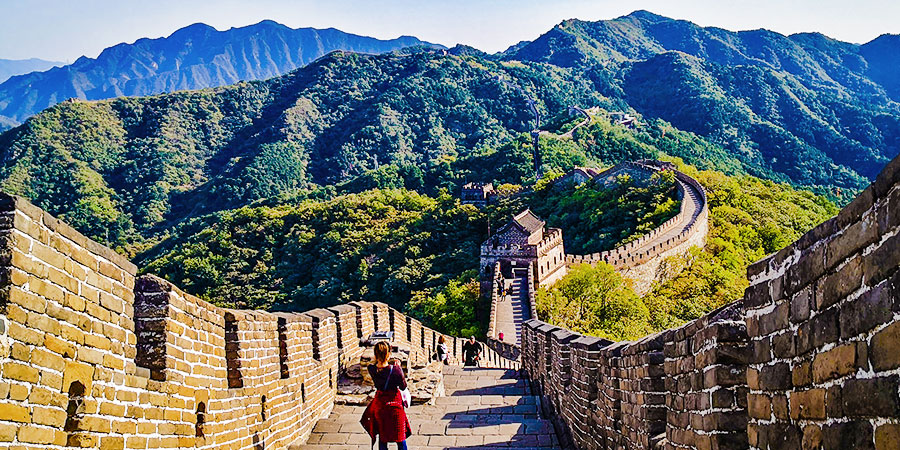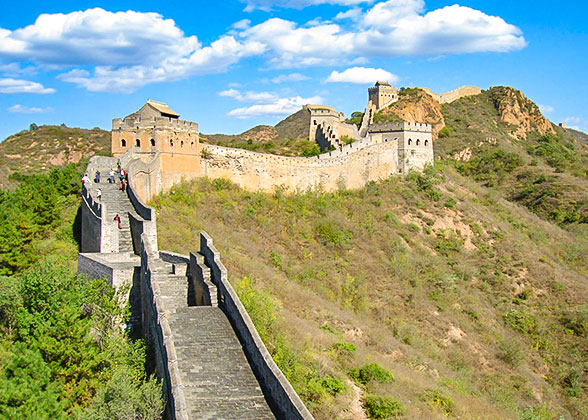Great Wall of China - One of the 7 Wonders of the World
 |
Why the Great Wall is titled one of the 7 wonders of the world?
1. It is a giant ancient military defense project second to none.
The Great Wall of China is a group of fortifications made of stones, bricks, sand, rammed earth, and other materials along mountain ridges, plains, desserts, and gobi, etc. It is not simply a ‘wall’, but a military defense project consisting of long connective walls, watch towers, passes, troop barracks and garrison stations. It was constructed mainly for preventing invaders, making enemies harder to break the northern border of the ancient China.
2. Its construction lasted from 7th Century BC to 1878.
The earliest Great Wall construction can trace back to the Western Zhou Dynasty (1046 BC - 771 BC) but the most famous Great Wall was commissioned by China’s first emperor Qin Shi Huang during the Qin Dynasty (221 - 207 BC). After that, the rulers of the following dynasties such as Han (202 BC - 220), Jin (265 - 420), and Ming (1368 - 1644) all intermittently built the wall. Ming Dynasty is the last dynasty to construct the Great Wall in a large-scale and the remaining sections you can see today are mostly built during that period. But the construction actually lasted till the Qing Dynasty (1644 - 1911).![]() Read more about: How old is the Great Wall of China?
Read more about: How old is the Great Wall of China? 
3. It is as long as 21,196 km (13,171 mi)
According to the latest research, the sections of all the Great Wall of China measure 21,196 km (13,171 mi). Among them, the Ming Great Wall is 8,851.8 km (5,500 mi) long.![]() Read more about: How long is the Great Wall of China?
Read more about: How long is the Great Wall of China?
4. It traverses from east to west in northern China.
The Great Wall of China spreads in more than 15 provinces and cities across the country, including Beijing &Tianjin Cities, Hebei, Shanxi, Shaanxi, Gansu, Inner Mongolia, Heilongjiang, Jilin, Liaoning, Shandong, Qinghai, Sichuan, Xinjiang Provinces and Ningxia Hui Autonomous Region. In general, the most-visited Great Wall sections like Badaling, Mutianyu, Simatai, Juyongguan are located in Beijing City and some sections in Hebei Province are also very popular, such as Jinshanling and Shaihaiguan while the Jiayuguan from the Han Dynasty situated in Gansu, northwest China is also well worth a visit.![]() Read more about: Where is the Great Wall of China located?
Read more about: Where is the Great Wall of China located?
New 7 Wonders of the World
The “New 7 Wonders of the World” were selected from a contest held by the non-governmental organization, the New 7 Wonders Foundation. More than 90 million people voted for the top seven wonders among 21 famous UNESCO World Heritage Sites through the internet, phones and messages. The candidate list includes some well-known landmarks like the Statue of Liberty, Eiffel Tower and Sydney Opera House. It is worth mentioning that the world-famous Great Pyramid of Giza (Pyramid of Khufu), the last remaining site of the ‘7 Wonders in the Ancient World’, did not participate in the competition. The final result was announced in Lisbon, Portugal and China’s Great Wall became the leader of the ‘New 7 Wonders of the World’. Here is a complete list of the other 6 wonders:
1. Petra, Jordan
Petra City is a historical city built in 4 Century BC-2 Century AD. Located about 260 km (161 miles) away from Jordan’s capital Amman, it features the grand structure carved out of pink sandstones and thus it has also been called “Ancient Rosy City”.
2. Christ the Redeemer Statue, Rio de Janeiro, Brazil
Built in 1926 -1931, the 38 m (125 ft.) high Jesus Christ statue on the top of Mount Corcovado, Rio de Janeiro is one of the largest Jesus Christ statues in the world and becomes the landmark of Brazil, overlooking the whole city.
3. Machu Picchu, Peru
As Peru’s most-visited wonder, Machu Picchu is a well preserved Inca citadel built in the mid-15 century, and the ruin has been a witness to the glorious urban Inca Empire and the most important archaeological center to study South America’s history.
4. The Colosseum in Rome, Italy
Built in AD 72-82, the massive oval amphitheater is located in the center of Rome, once served for slave owners, nobles and civilians to watch the beast or slave gladiator wrestling in the ancient Rome Empire. It is representative work of ancient Roman architecture no matter in function, scale, technology or artistic style.
5. Chichen Itza, Mexico
Built in the Terminal Classic period, about the 5-13 century, this is a large pre-Columbian city constructed by the Maya people. It is also an important archeological site to research mysterious Maya Culture.
6. The Taj Mahal, India
The magnificent mausoleum made of ivory-white marbles was commissioned to build in Agra from 1632 to 1648 by the Mughal emperor Shah Jahan for his beloved wife, epitomizing the great Indian architecture.
7 Wonders of the Medieval World
The Colosseum in Rome, Italy
The Catacombs of Kom El Shoqafa, Egypt
The Great Wall of China
Stonehenge, England
The Leaning Tower of Pisa, Italy
The Porcelain Tower of Nanjing, China
Hagia Sophia in Istanbul, Turkey![]() Further Reading
Further Reading
![]() When Did the Great Wall Become Famous? – Early 20th Century
When Did the Great Wall Become Famous? – Early 20th Century
![]() Who built the Great Wall of China?
Who built the Great Wall of China?
![]() Which one is better, Badaling or Mutianyu?
Which one is better, Badaling or Mutianyu?
![]() Fun Facts about Great Wall: 25 Things You didn’t Know
Fun Facts about Great Wall: 25 Things You didn’t Know
![]() Great Wall of China Facts for Kids
Great Wall of China Facts for Kids